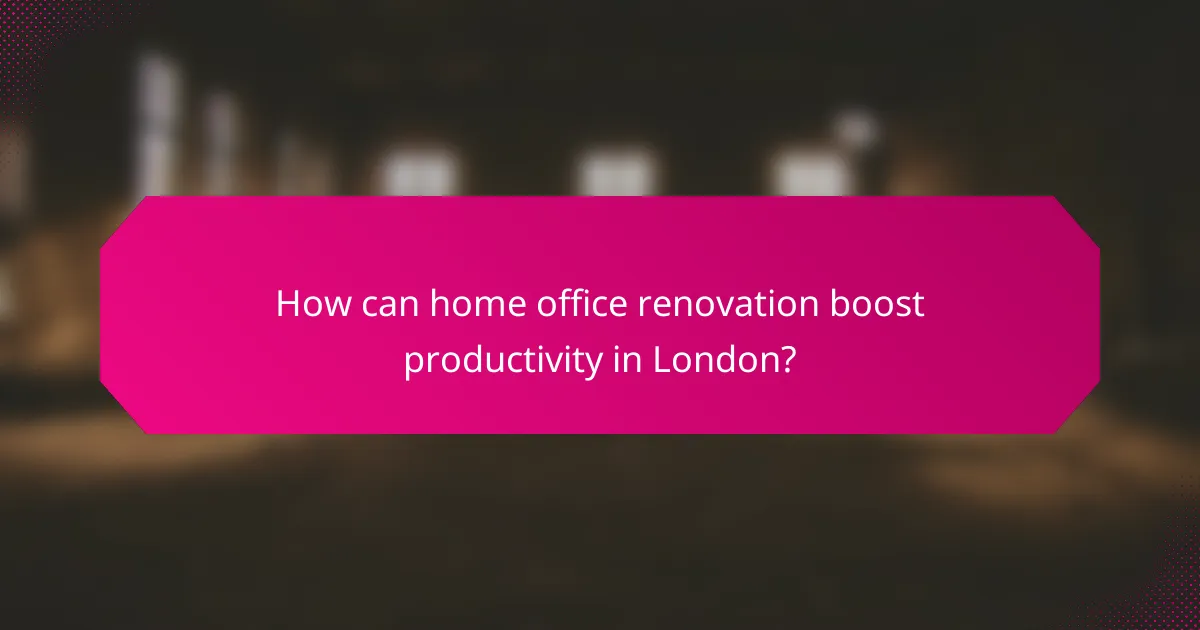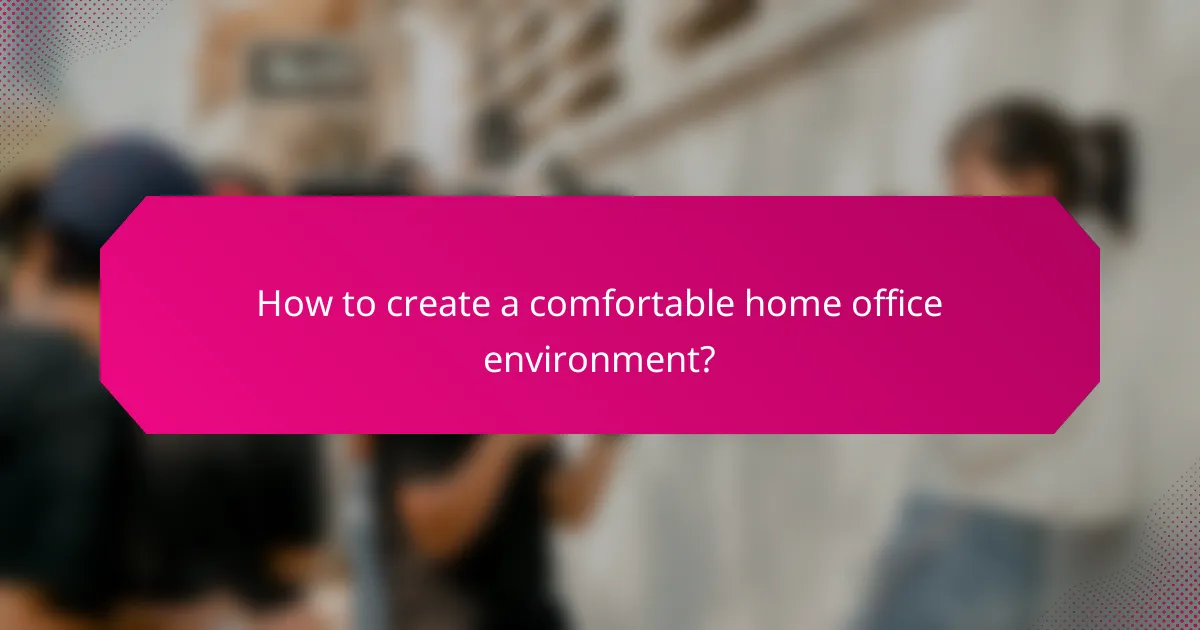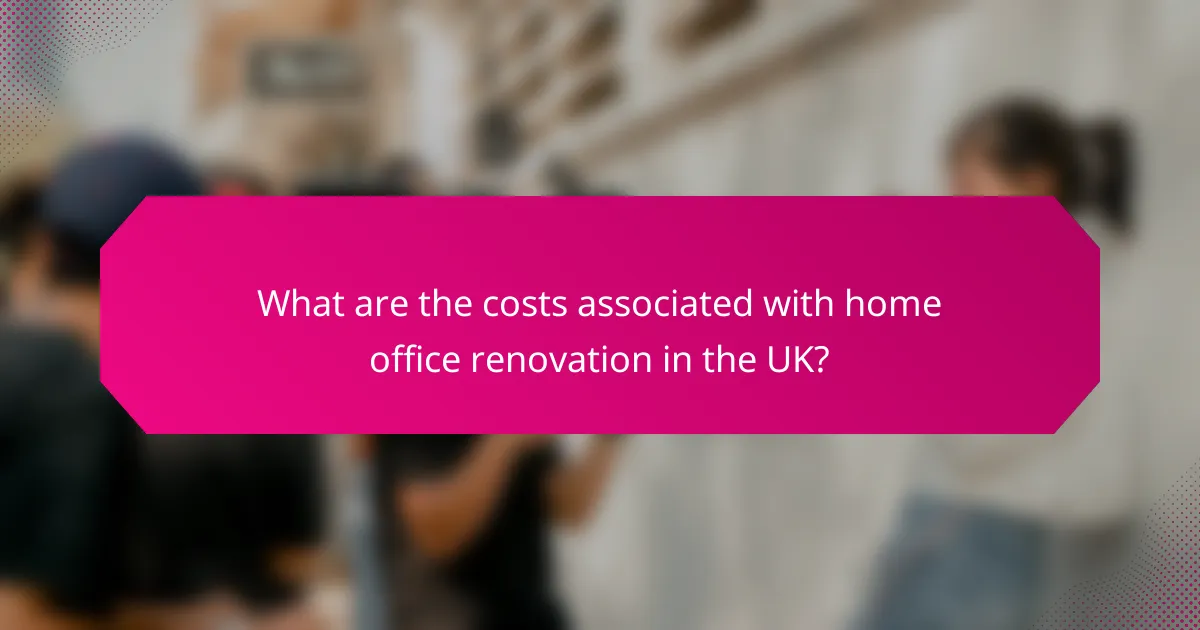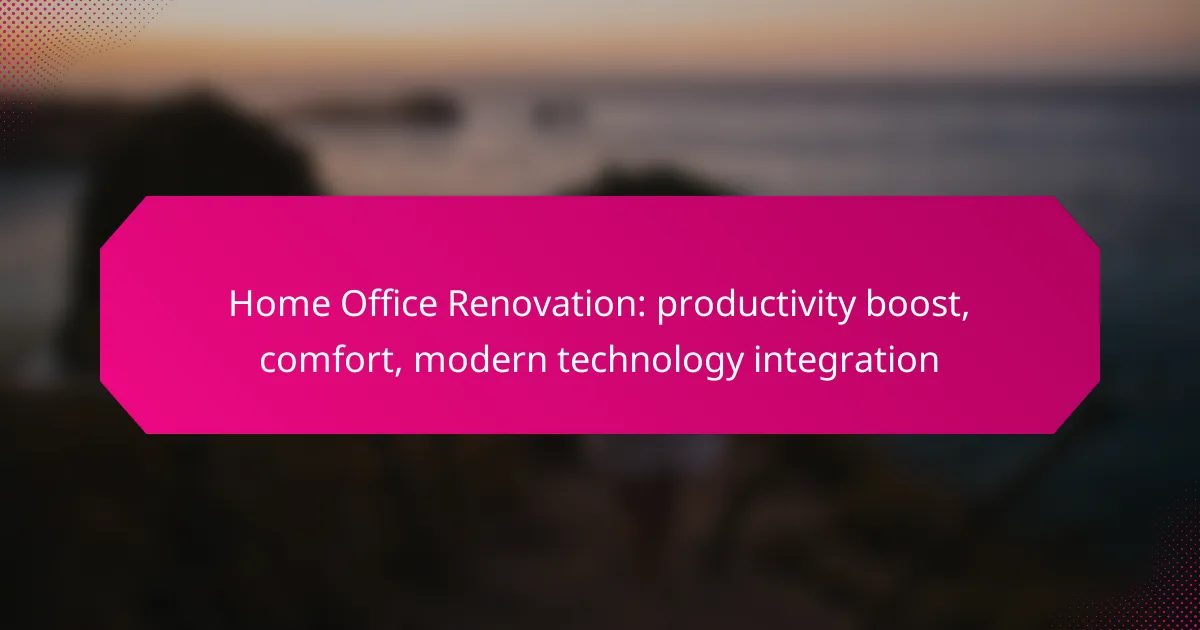A well-planned home office renovation can transform your workspace into a hub of productivity and comfort. By integrating modern technology and thoughtful design, you can create an environment that not only enhances focus but also reflects your personal style. From smart lighting to efficient organization, every element plays a crucial role in fostering creativity and efficiency.

How can home office renovation boost productivity in London?
A well-planned home office renovation can significantly enhance productivity by creating a comfortable and efficient workspace. By integrating modern technology and thoughtful design elements, you can foster an environment that encourages focus and creativity.
Ergonomic furniture benefits
Investing in ergonomic furniture is crucial for maintaining comfort during long working hours. Chairs with lumbar support and adjustable desks can help reduce strain on your body, leading to less fatigue and improved concentration. Consider options that allow for sitting and standing to promote movement throughout the day.
In London, you can find a variety of ergonomic furniture retailers, offering everything from chairs to desks tailored to your needs. Look for products that meet established ergonomic standards to ensure optimal support.
Optimized lighting solutions
Proper lighting is essential for a productive home office. Natural light is ideal, so position your desk near windows whenever possible. If natural light is limited, invest in adjustable LED lighting that mimics daylight and reduces eye strain.
Consider using smart lighting systems that allow you to adjust brightness and color temperature throughout the day. This adaptability can help maintain your energy levels and focus, especially during darker months in London.
Noise reduction techniques
Minimizing noise distractions is vital for maintaining productivity in your home office. Soundproofing materials, such as acoustic panels or rugs, can help absorb sound and create a quieter environment. Additionally, consider using noise-cancelling headphones during work hours.
Incorporating plants can also aid in noise reduction while enhancing the aesthetic of your workspace. Strategically placing larger plants can help block sound waves, contributing to a more peaceful atmosphere conducive to concentration.

What modern technologies can be integrated into a home office?
Modern technologies that can enhance a home office include smart lighting systems, wireless charging stations, and high-speed internet solutions. These innovations improve productivity, comfort, and overall efficiency in a workspace.
Smart lighting systems
Smart lighting systems allow you to control the brightness and color of your office lights through apps or voice commands. These systems can adapt to your daily schedule, providing bright white light during work hours and softer tones in the evening to promote relaxation.
When choosing smart lighting, consider compatibility with existing fixtures and the ability to integrate with other smart home devices. Look for options that offer energy efficiency, as they can help reduce electricity costs over time.
Wireless charging stations
Wireless charging stations eliminate the clutter of cords and cables, providing a convenient way to keep devices powered. These stations use electromagnetic fields to transfer energy, allowing you to charge compatible smartphones, tablets, and other gadgets simply by placing them on the pad.
When selecting a wireless charging station, ensure it supports the latest charging standards, such as Qi, for optimal performance. Consider the number of devices you need to charge simultaneously and choose a station that meets those needs.
High-speed internet solutions
High-speed internet is essential for a productive home office, enabling smooth video conferencing, quick downloads, and seamless collaboration. Options include fiber-optic connections, cable internet, and 5G networks, each offering varying speeds and reliability.
Evaluate your internet needs based on the number of devices and users in your home office. Aim for a connection speed of at least 100 Mbps for optimal performance, especially if multiple users are streaming or working online simultaneously. Consider upgrading your router to ensure strong coverage throughout your workspace.

How to create a comfortable home office environment?
Creating a comfortable home office environment involves optimizing factors like temperature, decor, and organization to enhance productivity and well-being. Focus on personalizing your space to reflect your style while ensuring it meets functional needs.
Temperature control options
Maintaining an ideal temperature is crucial for comfort and productivity in a home office. Aim for a range between 20-22°C (68-72°F) to promote focus without causing fatigue. Consider using programmable thermostats or smart home systems to adjust temperatures automatically based on your schedule.
Portable fans or space heaters can provide additional comfort, but be mindful of energy consumption. Insulating windows and using blackout curtains can also help regulate temperature and reduce glare on screens.
Personalized decor choices
Your home office decor should reflect your personality while promoting a productive atmosphere. Choose colors that inspire you; for instance, blues and greens are calming, while yellows can stimulate creativity. Incorporate personal items like artwork or photos to make the space feel inviting.
Consider ergonomic furniture that complements your style and supports your health. A well-chosen desk and chair can make a significant difference in comfort during long working hours.
Space organization strategies
Effective organization is key to a functional home office. Start by decluttering your workspace; keep only essential items within reach to minimize distractions. Use storage solutions like shelves, filing cabinets, or desk organizers to maintain order.
Implement a system for managing documents and supplies, such as color-coded folders or labeled bins. Regularly reassess your layout and adjust as needed to ensure your workspace remains efficient and conducive to productivity.

What are the costs associated with home office renovation in the UK?
The costs of home office renovation in the UK can vary significantly based on factors such as the scope of the project, materials used, and technology upgrades. On average, homeowners might expect to spend anywhere from a few thousand to tens of thousands of pounds, depending on the desired level of comfort and modernity.
Average renovation costs
Typical home office renovations in the UK range from £3,000 to £15,000. This includes expenses for furniture, decor, and essential renovations like painting and flooring. For more extensive upgrades, such as adding built-in storage or soundproofing, costs can rise to £20,000 or more.
When planning your budget, consider obtaining multiple quotes from contractors to ensure competitive pricing. This can help you gauge the average costs in your area and avoid overpaying.
Budgeting for technology upgrades
Integrating modern technology into your home office can enhance productivity but also adds to the overall renovation costs. Expect to budget around £500 to £2,000 for essential tech upgrades, including high-speed internet, ergonomic equipment, and smart lighting systems.
Prioritize essential technology that directly impacts your work efficiency. For instance, investing in a reliable computer and a good-quality monitor can significantly improve your workflow compared to less critical gadgets.
Cost-saving tips for renovations
To save on home office renovation costs, consider DIY options for minor tasks like painting or assembling furniture. This can reduce labor costs significantly. Additionally, shopping during sales or using second-hand furniture can help stretch your budget further.
Another effective strategy is to focus on one area at a time rather than renovating the entire office at once. This phased approach allows you to manage expenses better and make adjustments based on your evolving needs.

What are the key factors to consider before renovating a home office?
Before renovating a home office, it’s essential to evaluate space, personal needs, and future-proofing elements. These factors ensure the workspace enhances productivity, comfort, and integrates modern technology effectively.
Space assessment criteria
Assessing the available space is crucial for a successful home office renovation. Consider the room’s dimensions, natural light, and existing layout. Aim for a minimum of 100 square feet to allow for a desk, chair, and storage while maintaining a comfortable environment.
Evaluate the flow of the space as well. Ensure there is enough room for movement and that the office is not cluttered. A well-organized layout can significantly impact productivity and comfort.
Identifying personal needs
Understanding your personal needs is vital for creating an effective home office. Consider your work style, tasks, and any specific requirements, such as ergonomic furniture or soundproofing. For instance, if you spend long hours at your desk, investing in an adjustable chair and desk can enhance comfort.
Make a list of essential tools and technology you require, such as a high-speed internet connection, multiple monitors, or specific software. Prioritize these needs to ensure your renovation aligns with your work habits.
Future-proofing considerations
Future-proofing your home office involves planning for technological advancements and changing work patterns. Consider incorporating smart technology, such as automated lighting and climate control, which can enhance comfort and efficiency.
Additionally, think about flexibility in your design. Modular furniture can adapt to different tasks or team setups, while ensuring that wiring and outlets are easily accessible for future upgrades. This approach can save time and money in the long run.

How can home office design trends influence productivity?
Home office design trends can significantly enhance productivity by creating a workspace that promotes focus, comfort, and efficiency. Thoughtful integration of modern technology and ergonomic furniture can lead to a more inspiring and functional environment.
Ergonomic furniture and layout
Choosing ergonomic furniture and an efficient layout can reduce discomfort and fatigue, allowing for longer, more productive work sessions. Consider adjustable desks that allow you to alternate between sitting and standing, which can improve circulation and energy levels.
Additionally, ensure that your chair supports good posture, with adjustable height and lumbar support. A well-organized layout that minimizes distractions and maximizes natural light can further enhance your focus and productivity.
Technology integration
Integrating modern technology into your home office can streamline tasks and improve workflow. High-speed internet, dual monitors, and smart devices can enhance your ability to multitask and access information quickly.
Consider investing in noise-canceling headphones or smart speakers to create an environment conducive to concentration. Utilizing productivity apps and project management tools can also help keep you organized and on track.
Personalization and comfort
Personalizing your home office can foster a sense of ownership and comfort, which can boost motivation. Incorporate elements that inspire you, such as artwork, plants, or personal mementos.
Ensure that your workspace is well-ventilated and at a comfortable temperature. Adding soft lighting and sound-absorbing materials can create a calming atmosphere that enhances focus and reduces stress.
